#gilt embellishments
Photo
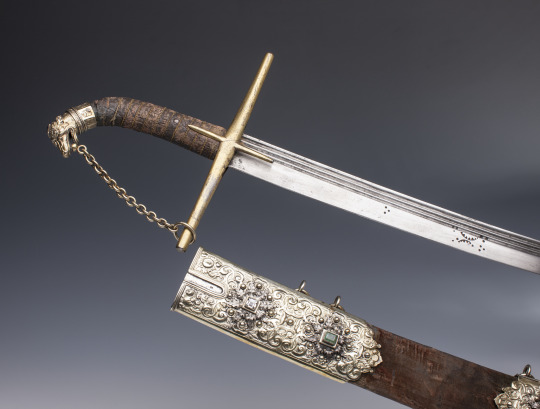
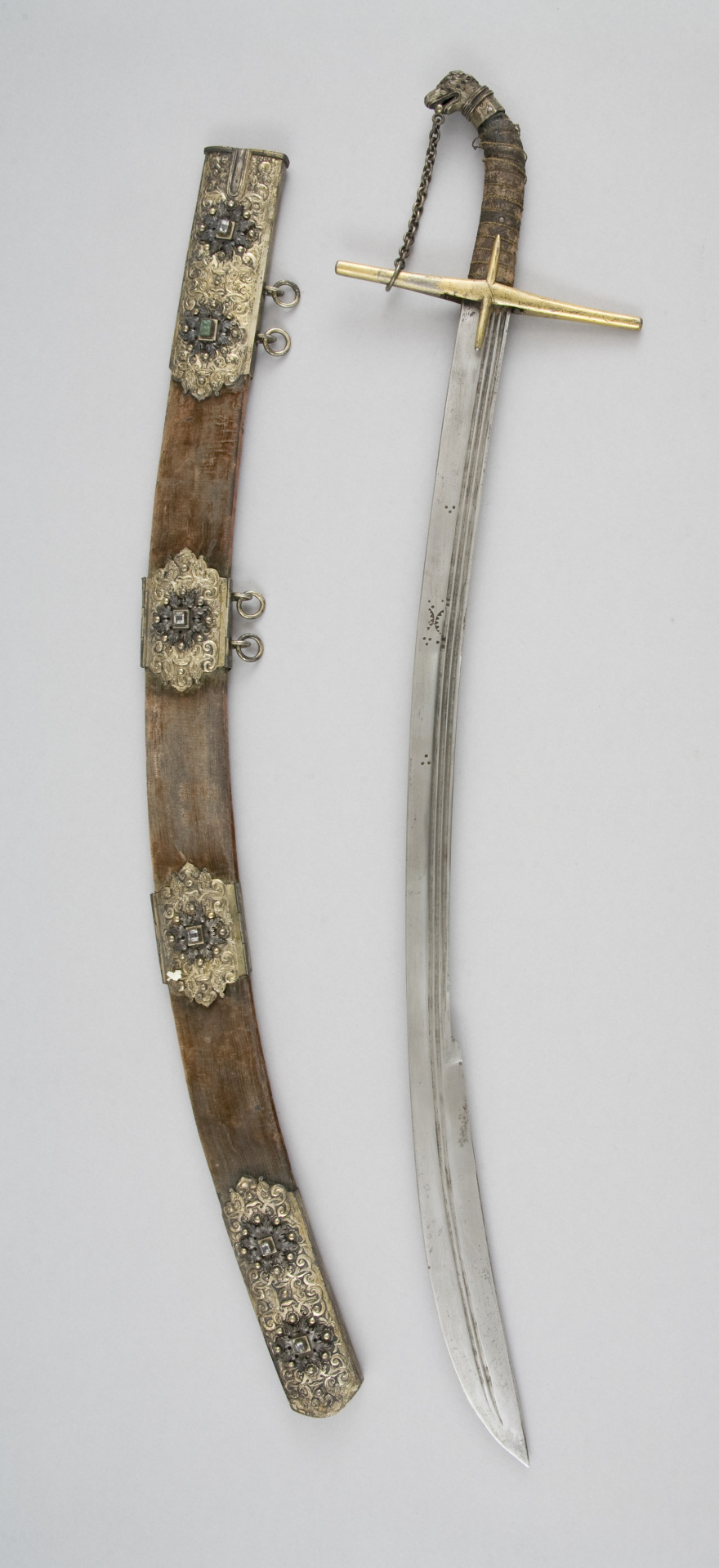
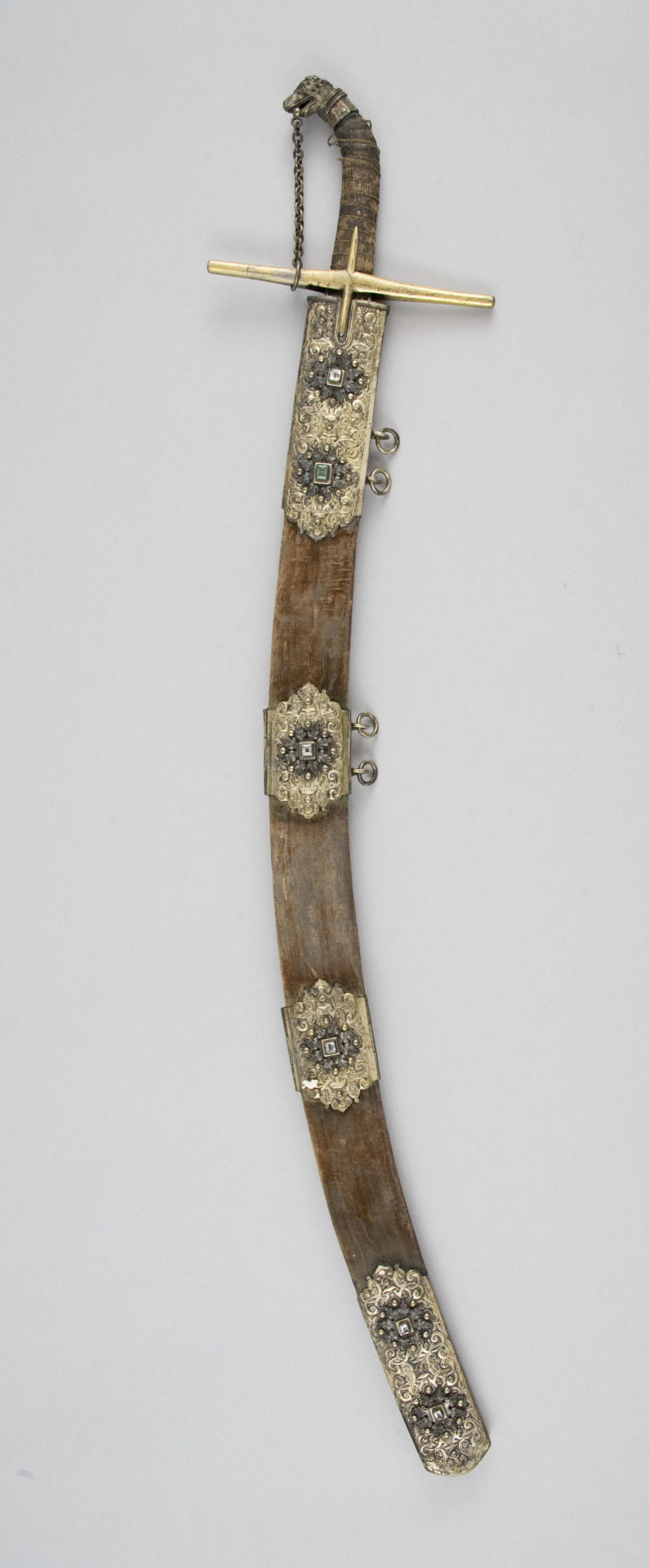
A fabulously gilt Sabre embellished with quartz and emerald,
OaL: 36.1 in/91.8 cm
blade from Dresden, Germany, hilt and fittings from Genua, Italy, 1687, housed at the Czartoryski Museum, Krakow.
#weapons#sword#sabre#europe#european#italy#italian#genoa#germany#german#dresden#hre#holy roman empire#early modern#czartorynski museum#art#history
606 notes
·
View notes
Text

MAHZOR. (Tuscany, c1490) A Jewish holiday prayerbook. Gold highlights, initial word panels throughout in burnished gold on red, green or blue grounds, some embellished with marginal sprays, text illustrations Edges gilt and gauffered
Mid 16th-century Italian gold-tooled dark brown goatskin over thin wooden boards with strapwork painted in red and yellow, both covers with central cartouche with coat of arms, elaborately decorated with a unicorn and rabbit, hatched leaf and flower tools, solid dots and foliate rolls.

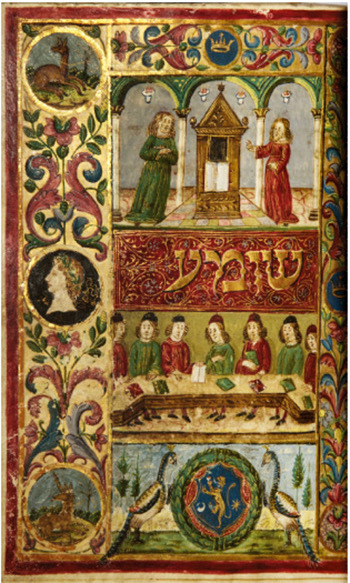
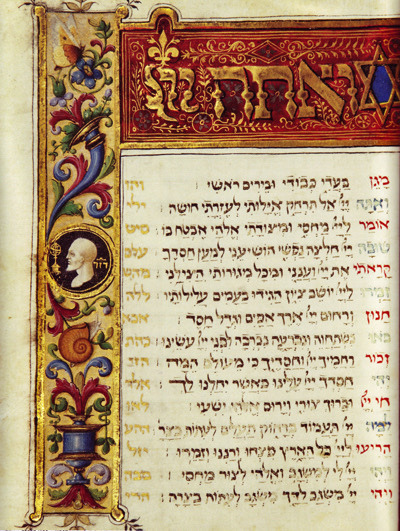

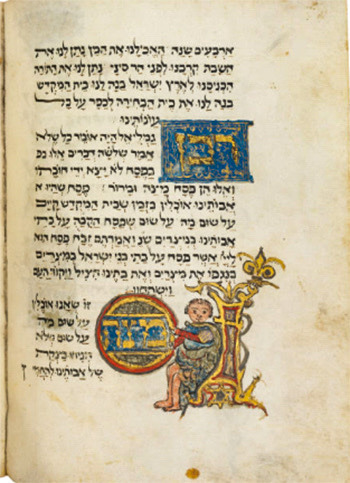

source
#beautiful books#book blog#books books books#book cover#books#vintage books#illustrated book#hebrew#mahzor#15th century#gauffered edges#illuminated manuscript#fore edge painting
55 notes
·
View notes
Text

French Empire Centerpiece Perfume Burner in Gilt Bronze and Marble
Two winged Hermes playing trumpets sit on the perfume dish and form the handles. They sit on a rim decorated with alternating masks and griffins. The gadrooned underside of the bowl meets a polished stem that ends in a ring of spiraling beadwork at the foot. This foot rests on a rectangular base decorated with a relief of four figures in a landscape. The base is supported by four massive claw feet embellished with foliage, and the entire set rests on a black marble plinth. circa 1810
14 notes
·
View notes
Text
The 1539 gift exchange roll format was a harbinger of the 1557 Marian roll, detailing the king’s family and courtiers with Henry’s added embellishment to the court ceremony. A specially prepared gift chamber with “trestles and boards for the King’s New Year gifts to stand upon” was prepared for Henry to watch during the day as servants brought gifts and received rewards for their part in delivering the gifts. There was no queen in this year, therefore the primary group of close relatives was composed of Prince Edward, Lady Mary, Lady Elizabeth, and Lady Margaret Douglas, the King’s niece. All three children received gilt plate from their father: Edward’s gift weighed 209 ounces, Mary’s gift weighed 123 5/8 ounces, and Elizabeth received 90½ ounces. The gift roll does not record Edward and Elizabeth’s gifts to the king, but Mary’s gift was a chalcedony salt with a mother of pearl lid, all garnished with gold. She gave her brother Edward an embroidered crimson coat with pansies and gold aglets and her sister Elizabeth, a kirtle of yellow satin. The bishops followed as lords spiritual and the other peers in order of their social rank and precedence as lords temporal. The final groupings were courtiers and crown servants with close access to the sovereign. Participation in the gift exchange was an obligation of office or social rank for some and a privilege for others.
— Mary’s Participation in the Ritual of the New Year’s Gift Exchange as Princess and Queen by Jane Lawson, 2022. In Mary I in Writing: Letters, Literature, and Representation, edited by Valerie Schutte and Jessica S. Hower
#historicalquotes#tudorerasource#dailytudors#history#Mary I of England#Elizabeth I of England#Edward VI of England#Henry VIII of England#Margaret Douglas#culture#correspondence#Gift Exchange roll#Lawson tag#*mine#*quotes
14 notes
·
View notes
Text
Gilt leather shoes in 16th c. Ireland
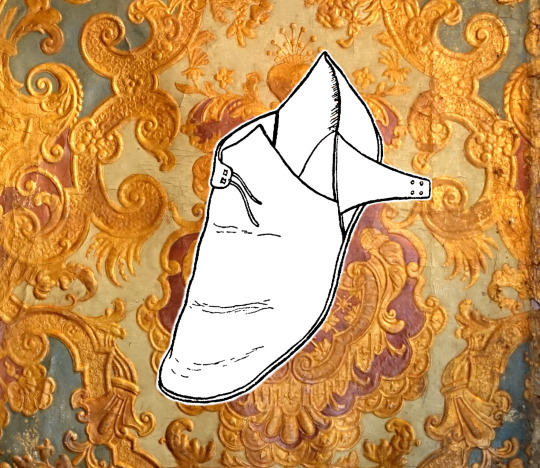
Drawing of a 16th c. Irish shoe by A. T. Lucas over a gilt leather wall hanging from the National Museum Machado de Castro in Portugal
In his 1518 description of Irish clothing, Laurent Vital says the following about shoes worn by Irish women and girls:
Elles portent petits soliers à singles semelles, bien jolys et mignotz, ouvrés pardessus d'aultres couleur de cuyr et parfois doretz de cuyr estainnet, comme s'il estoit doré, et comme j'ay veu porter les enffans parcy-devant, quant on leur achetoit des soliers de ducasse.
They wear little shoes with single soles, very pretty and cute, finely worked on top with other colors of leather and sometimes adorned with gilt leather, as if they were gilded, like the shoes which were bought for children at fairs in past times.
(translation by Dorothy Convery, edited by me)
In this post, I discuss what Laurent Vital meant by gilt leather and how it might have been used in 16th c. Irish shoes.
Sadly, we do not have any surviving examples of gilt leather shoes from medieval or early modern Ireland. This is unsurprising, because gilt leather is a fragile material which can be destroyed by excessive moisture, (Gilt Leather Society 2019) and most surviving Irish shoes have been found in damp locations like bogs, crannogs, and wells (Lucas 1956, Miller 1991, Nicholl 2023).
As Vital points out, although medieval doretz de cuyr or gilt leather looks like gilding, it is not really gold. Gilt leather was made from carefully prepared leather that was sealed with rabbit-skin glue and then had silver foil placed on top of it. The foil was then painted with a yellow varnish, giving it its golden appearance (Pereira 2012). Gilt leather could be stamped with patterns or painted with designs.
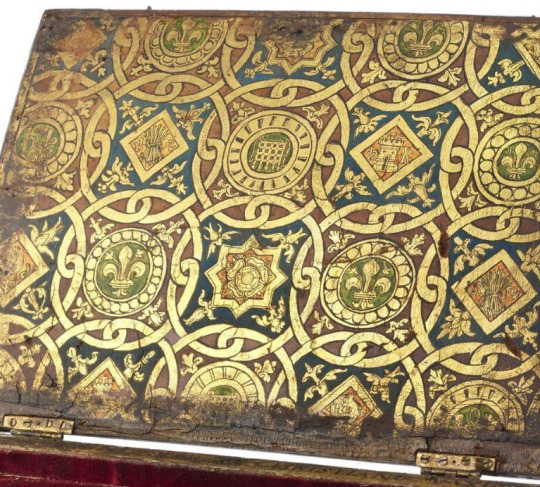
Painted gilt leather on a writing box belonging to King Henry VIII, made circa 1525 Victoria and Albert Museum collection
Learning what gilt leather actually was left me puzzled as to how the Irish made shoes out of it. Early 16th c. Irish shoes were largely made using a turnshoe or turn-welt construction. These methods involve sewing the shoe together inside out and then turning it right side out. In order to turn successfully, the shoe leather needs to be thin and flexible. Turnshoes are typically soaked in water to soften them before they are turned (Miller 1991, Nicholl 2023). I would expect that the layers of rabbit-skin glue and varnish in gilt leather would make the leather too stiff to turn. Also, as previously noted, being soaked with water is bad for gilt leather.
Although there are no surviving Irish examples of gilt leather shoes, there are a few continental European examples of episcopal sandals from the 12-13th centuries which appear to be embellished with gilt leather.
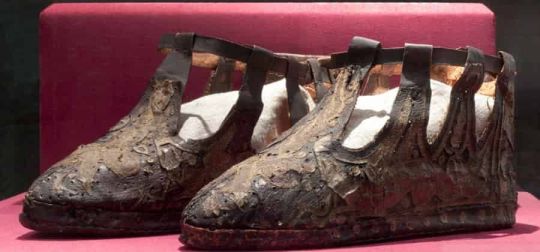


All of these shoes have a base layer of plain leather; the gilt leather is an applique which is glued or stitched on top. This method of construction is consistent with Vital's description that Irish shoes were estainnet i.e. adorned or plated*, with gilt leather. This method also explains how it was possible for Irish shoemakers to make shoes with gilt leather. Turnshoes of plain leather could be appliqued with gilt after they were turned right side out.
*estainnet: modern French étamer: to tin plate or to plate with metal
Irish shoemakers probably used gilt leather that was imported from Spain. During the Middle Ages, gilt leather was made in Spain and Portugal. It was not made elsewhere in Europe until the 17th century. (Pereira 2012). 16th c. Irish merchants imported luxury goods like silk and wine from Spain (Flavin 2011).
Neither Vital's account nor period illustrations give us any idea what kind of designs these Irish gilt shoes had on them. Rinceaux or scrolling foliage motifs like those on the sides of the 16th c. St. Brigid's shoe shrine are a likely option.
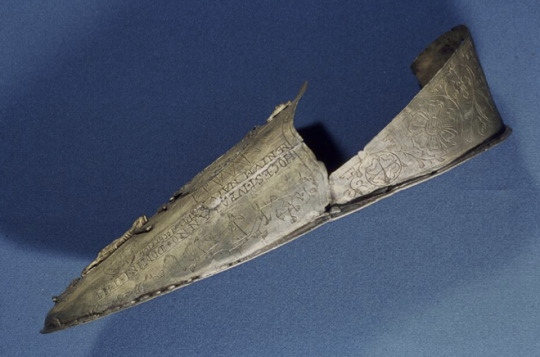
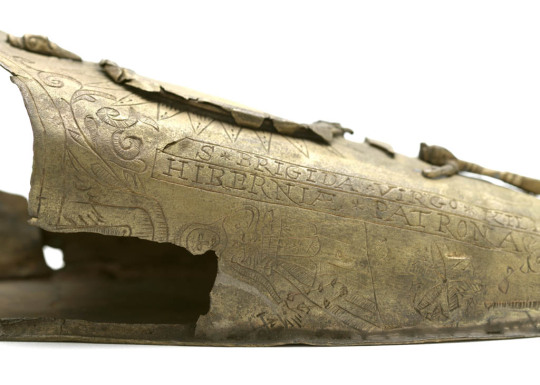
Further reading: Robert Gresh of the group Wilde Irish has written an interesting article on evidence for the use of gilt leather in 16th c. Irish armor. Download here
Bibliography:
Dictionnaire du Moyen Français 2020
Flavin, Susan (2011). Consumption and Material Culture in Sixteenth-Century Ireland. [Doctoral thesis]. University of Bristol.
The Gilt Leather Society. (2019). Conservation Challenges. https://giltleathersociety.org/conservation/conservation-challenges/
Lucas, A. T. (1956). Footwear in Ireland. Journal of the County Louth Archaeological Society, 13(4), 309-394. https://www.jstor.org/stable/27728900
Miller, O. G. (1991). Archaeological Investigations at Salterstown, County Londonderry, Northern Ireland. [Doctoral thesis]. University of Pennsylvania.
Nicholl, John (2023). https://broguesandshoes.com/
Pereira, Franklin (2012). Gilt leather/guadameci in Coimbra – comments on documents of the 12th and 16th centuries. Boletim do Arquivo da Universidade de Coimbra, 15, 169-180. http://hdl.handle.net/10316.2/5514
Ryan, Trisha (2022). Online Pop Up Talk: St. Brigid's Shoe Shrine. National Museum of Ireland Archaeology. https://www.museum.ie/en-IE/Museums/Archaeology/Engage-And-Learn/For-Adults/Online-Pop-Up-Talk-St-Brigid-s-Shoe-Shrine
Vital, Laurent (1518). Archduke Ferdinand's visit to Kinsale in Ireland, an extract from Le Premier Voyage de Charles-Quint en Espagne, de 1517 à 1518. http://research.ucc.ie/celt/document/T500000-001
#irish dress#dress history#16th century#gaelic ireland#historical fashion#shoes#historical women's fashion#irish history#brog#anecdotes and observations
7 notes
·
View notes
Text




Universal Swords – British 1796 Light Cavalry Saber with Blued and Gilt Blade
This British 1796 Cavalry Saber has been beautifully embellished with a blued and gilt treatment at the base of the blade which was a popular adornment for military officers to dignify their swords above the standard issue to match their rank and station. The tempered blade is forged from 1055 high carbon steel and the hilt is steel with a wood and leather grip. The blade is peened over the pommel to solidly fit the blade into the hilt. The sword is matched with a steel scabbard completed with steel hanging rings.
The British pattern 1796 Cavalry Saber was used by the Hussars, Light Dragoons and Kings German Legion Light Cavalry of the Napoleonic Era. The sword was designed by John Gaspard Le Marchant, one of the finest cavalrymen of his day who bemoaned the long and heavy swords then in use by his expeditionary force during their experience in France during its Revolutionary War. His design became one of the most lauded of cavalry sabers.Unlike its predecessor, the 1796 saber had a more pronounced curve, making slashing easier and deadly. The saber, somewhat unusually among its peers, also widened at its tip, putting weight and heft at the tip making its slashes more vicious.
#Kult of Athena#KultOfAthena#New Item Wednesday#Universal Swords#British 1796 Light Cavalry Saber with Blued and Gilt Blade#British 1796 Light Cavalry Saber#sword#swords#weapon#weapons#blade#blades#European Weapons#European Swords#Early Modern Swords#Early Modern Weapons#18th century
13 notes
·
View notes
Text

A 20th century Continental silver-gilt, gilt metal and enamelled chess set
possibly Austro Hungarian, incuse stamped 925
Mounted on a wood base with foliate engraved gilt-metal sides each applied with blue and white enamelled plaques depicting knights, each corner fitted with a knight and embellished with gem set scrolling foliate, the chequerboard hinging open to reveal a velvet lined storage compartment for thirty-two silver, silver-gilt and enamelled conventional chess pieces, raised on four pierced scrolling foliate gem set feet.
Bonhams
12 notes
·
View notes
Text



Peshwaz, late 18th century to early 19th century, India
Fine muslin ground with decoration in applied tinsel, spangles and foil. The peshwaz was made for a small wearer. The bodice portion is heavily embellished with wide bands of decoration around the sleeves, neck, hem, front-opening, and down the middle of the ground panels. The bands are made of silver-gilt, bordered by strips of green foil, with rows of blossoms in red foil and sequins. The same style of bands decorate the edges and hems of the skirt panels, and the wrists of the sleeves. The main ground of the sleeves and skirt is embellished with a motif of silver-gilt strip couched into four-petal blossoms, regularly divided by serrated rows of silver-gilt foil. A deep striped trim lines the inside bottom hem of the skirt.
3 notes
·
View notes
Text
godddddd i'm so sorry for contributing to the book-buying-hoarding-invoking-capitalism thing but i am not immune to the special barnes and nobles editions of classics. i'm really not. my barnes and nobles editions of books with the bright colors and gilt embellishments mean so so much to me
#went crazy during that 50% off sale with a few different gift cards and now i have So many of them...#they're so beautiful. they're my everything. i am going to read them all now that i'm out of my reading slump#i never buy these things at full price! even my beloved penny dreadfuls collection was like. either half off or 25 percent off when i got i#which is why i got it. can't turn down the chance to get them at a cheaper price when they're so beautiful and i want them so bad.#valentine notes
10 notes
·
View notes
Photo

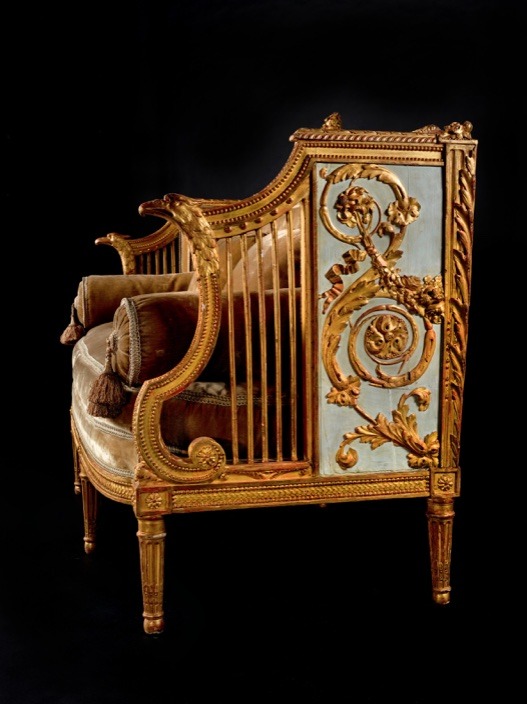

A LOUIS XVI PARCEL-GILT AND GRAY-PAINTED CANAPE
BY GEORGES JACOB, CIRCA 1785
The shaped top rail with laurel-leaf and berry cresting centered by a shell surmounted by a floral garland above a scrolling acanthus leaf volute flanked by further garlands, above a padded back and seat upholstered in taupe velvet, the arms modeled as lyres surmounted by eagle heads with rope and stiff-leaf embellished uprights with scrolling ribbon-tied sides centered by a flowerhead, the seat rail carved with chutes de piastres, on tapering baluster-turned and stop-fluted legs headed by rosettes with toupie feet, with two loose cushions and two bolster cushions, stamped 'G. IACOB'.
41 3/4 in. (106 cm.) high, 75 in. (190 cm.) wide, 24 1/2 in. ( 62 cm.) deep.
#A LOUIS XVI PARCEL-GILT AND GRAY-PAINTED CANAPE#GEORGES JACOB CIRCA 1785#furniture#french furniture#art#artist#art work#art world#art news#history#history news
21 notes
·
View notes
Photo
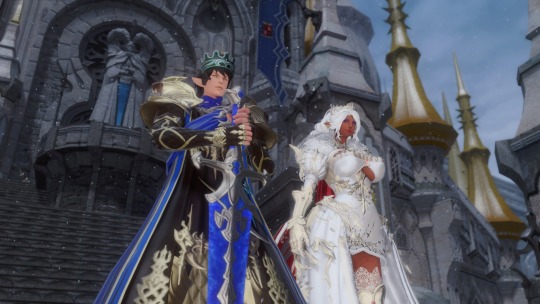

Junelezen Day 15 - Solar Cycle
He never wanted to be King.
Twas the scheme of the High Houses, of a surety. They came to him, the Comtes de Durendaire and Haillenarte, and the Comtesse de Dzemael, and begged it of him; only the three, for Artoirel was dubious.
One thousand years it stood empty, King Thordan’s throne; twas the Orthodox throne, gilt by deceit, that reigned sovereign high above the Holy See. But the ancient sins which served as the very foundation of the Holy See were hidden no more. The people were fractious, divided. Ishgard needed somewhat around which to unite, to believe in. The people would still have their voice, yes, in Parliament; the High Houses gave their assent.
Once more, as it was upon the distant reflection which birthed me, I saw the wisdom in it even as my heart shattered against giving up a man I loved beyond all comprehension to a throne of which he did not believe himself worthy. Once more, he did not want it; but Aymeric is not Alistair, and he too saw the wisdom in it. He restored the covenant with Dragonkind; and he restored the throne, and claimed it, as the bards sing. The philosophers of ancient Nym spoke ancient truth when they said that time flows like a river, and history repeats again and again...
But these waters did not flow entirely the same. For in Ishgard, twas no poisonous Arl threatened by my counsel in my beloved King’s ear; only a pair of Comtes who held us both like unto their own flesh and blood. Only a city and a people who embraced me with love most profound and a gratitude beyond measure. None would call the Sorceress of Light, Nidhogg’s Bane, a curse upon the crown.
As I vowed to Haurchefant, I would be no man’s secret shame; I would be his glory, or nothing at all. I am King Aymeric’s glory, as we all are--Haurche, and Vivi, and Estinien--even Ysayle.
And when I say to you those frigid snows ceased when he unsheathed Naegling, and the clouds parted, and the sun shone brilliant and warm down upon the Hoplon, pray do not think it the fanciful embellishment of a besotted Trouvère, though I am what I am, as always.
In Ishgard, even a Dalish daughter of the stews of Denerim might be a Princess.
#junelezen#junelezen 2022#aymeric de borel#gisele surana#aymeric x wol#bisho's adventures in gpose#otp: promises kept#stupid sexy aymeric
56 notes
·
View notes
Text

HOLY BIBLE (c1644) gifted to Prince Charles Stuart, later Charles II.

The book is a petite 7 by 4 inches covered with an intricate design worked in silver gilt thread (a silk core wrapped in silver that has been dipped in gold) and embellished with spangles. The printer’s mark on the frontispiece shows a printing date of 1644, and the exact fit of the embroidery indicates it was made specifically for this Bible.
The needlepainted image of Charles is still vibrant and exquisitely detailed. It is strikingly similar to a painting by William Dobson dated 1642 or 1643, when the prince would have been 13. The ship on the back cover may be the Prince Royal, which was rebuilt in 1641.
source
#beautiful books#book blog#books books books#book cover#books#old books#christian bible#embroidery#charles ii of england#17th century
136 notes
·
View notes
Photo

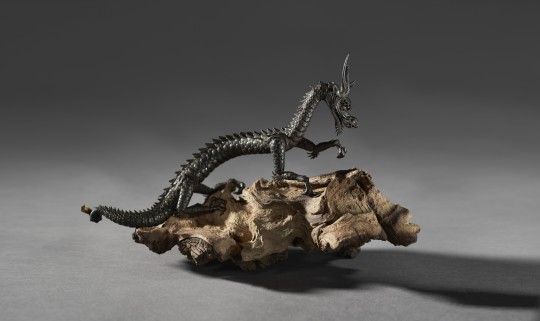
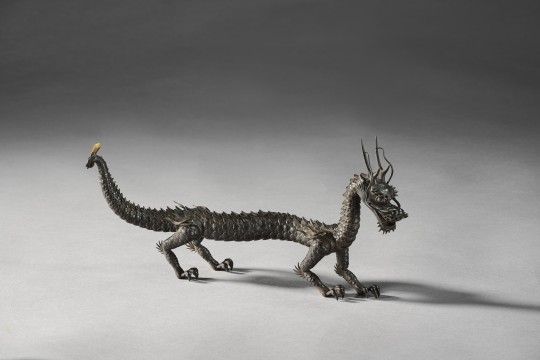

AN IRON ARTICULATED SCULPTURE OF A DRAGON,
Edo Period (19th Century),
Signed Kiyoharu (Myochin Kiyoharu),
The russet-iron dragon finely constructed of numerous hammered plates jointed inside the body; the hinged jaw opening to reveal a movable tongue, ears, limbs and claws move, the body bends, the head is applied with elaborate horns, spines and whiskers, the tail of the dragon entwining a double-edged gilt kurikaraken (sword), the details are finely carved and chiseled, the eyes of shakudo embellished with gilt; signature on underside of right arm.
13 1/3 in. (33.8 cm.) long
Courtesy: Christie’s
#art#design#sculpture#dragon#iron#articulated#edo period#19th century#japan#christie's#russet-iron#shakudo#gilt#kurikaraken#style#history
43 notes
·
View notes
Text
A pearl. Dark maroon in color. Like long-dried blood. It is a transcription of the feed transmitted by a looking device.
313.222.25.043 - FEED [AUDIOVISUAL]
A ROOM DIMLY LIT BY CONTAINED FLAME. INTRICATELY CARVED STONE TILE COVERS EVERY SURFACE AND FACET WITHININ ITS BOUNDARIES. A POOL OF UNREFLECTIVE FLUID RESTS IN A WIDE, DEEP RELIEF CHISELED OUT INTO THE GROUND. IT IS LARGER THAN A BED, AND CANDLES AND FLORA SURROUND IT. A STONE PLATFORM IS BORNE BY SIX FIGURES, WHILE ANOTHER SITS ATOP IT ON THEIR KNEES. STILL. MEDITATIVE. THE SURFACE OF THE PLATFORM IS EMBELLISHED BY SIMILAR CANDLES AND FLORA. THE FIGURE IS ADORNED WITH WHITE, FLOWING CLOTHS, A BEAUTIFULLY CARVED BONE MASK, AND GOLD REGAILIA WHICH HANGS OFF THEM, ALMOST SAILING BEHIND THEM. GOLDEN STRINGS OF BLUE-TINTED PEARLESCENT BEADS, SHINY GILT RIBBONS, AND SHAVINGS OF DIAMOND SHIMMER IN THE WARM LIGHT. THE SCENE IS SERENE, AS IN A BRILLIANTLY RENDERED PAINTING. GOLDEN ABERRATION EMINATES FROM THE VOID FLUID AND RADIATES THROUGHOUT THE ROOM. A DISTANT GRINDING IS HEARD. THE NOISE THAT NO LIVING BEING IS SUPPOSED TO HEAR.
Three Seeds, Resident of 1 living block, Member of the New Ascensionists' Opinion Collective, Secretary of the Ten Pyres Void Studies House, Mother, Father, Spouse, we praise and envy you for taking the plunge today. We celebrate your life as we will celebrate your ascension. We adorn you with our golden presents today as a display our admiration for your bravery. May your existence have been fulfilling, and may your ascension be peaceful.
THE FIGURES SET THE PLATFORM ONTO THE GROUND IN FRONT OF THE RELIEF. THE PERSON ON THE PLATFORM, MAKING THEIR FIRST OBSERVED MOVEMENT, STANDS. THE GOLDEN ABERRATION OVERPOWERS THE ROOM. SCREAMS OF ANGUISH ARE HEARD.
[END OF FEED]
7 notes
·
View notes
Note
📼
reaper's early childhood memories (closed until I get through some in my inbox)

He's been waiting for what feels like ages, but the guards finally change, and Reaper is able to dash from his hiding spot to the armory where the outpost keeps their weapons. Noxus makes no secret of how it takes the best parts — the strongest parts — of every place it conquers, so their selection is incredible, even for a smaller military branch like this one. The weapons glitter in the light of the candles in the room, the weapons remodelled to look Noxian, even if their shape speaks of a different origin. Reaper can tell which swords are from Shurima, the Freljordian bows, the Demacian shields — but there are some that even his studious research can't identify. All of them are silver and black, gilt with ruby embellishments so that every soldier may proudly display their allegiance.
Needless to say, Reaper wants one. He wants all of them, really, but he has to stick with what he can carry. When he's old enough to join the military he'll practise with all of them, climb the ranks and teach others to use them, but for now ...
Though he doesn't admit it to himself, for now he is a child, barely the same height as some of the swords, and the abandoned nook he calls home doesn't have room for all the weapons he'd like to keep and admire.
Running his fingers over the smooth metal, Reaper marvels at how cool they are to the touch, and how much heavier they are when they're right in front of him and not attached to the belt of a passing guard. Though there are countless weapons that he can choose from, there's one in particular that catches his eye. A battleaxe, taller than him with a blade nearly as wide (or perhaps slightly wider, depending on who you ask) than his shoulders. With glittering eyes, Reaper reaches towards where it leans against the wall, blade down, obviously just set aside for the moment rather than hung nicely, and grabs onto the handle near the blade, giving it a tug.
It doesn't budge. Reaper gives it another tug, then yanks hard, and still the weapon barely scratches the floor as it edges towards him. He wraps his hand a little higher around the weapon's shaft and throws his back into pulling it, but all that does is make the handle swing down, barely avoiding his head before it clunks heavily onto the floor. Reaper freezes, ears pricked for danger as the sound reverberates through the room, and decides he can come back for the battleaxe. It's not hard to sneak in, and here's plenty of weapons in the meantime to keep him occupied. So he grabs a handaxe off the wall, attaching it to his belt the way he sees the soldiers do, along with a box of throwing knives and a small Shuriman blade. The brass knuckles are too large for his hands still, and he ends up dropping an armblade on the ground in his haste, so he leaves those for now — he'll be bigger next time, after all, so he'll be able to carry all three that he left behind today.
He turns to leave, and at the last second darts back for the brass knuckles, tucking them in his pocket. He likes the way the rubies glint like blood along the knuckles, and figures he'll be able to use them soon enough anyways. Then, with a final glance at the wall of weapons, Reaper turns and peeks his head out of the door, checking for guards before he darts away, out of the outpost and back home to admire his haul.
#what was written in shadow — now in flesh / answered.#witchcraftandburialdirt#he was always like this actually
3 notes
·
View notes
Text

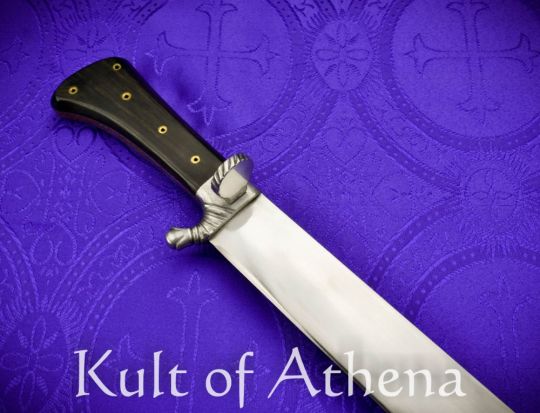
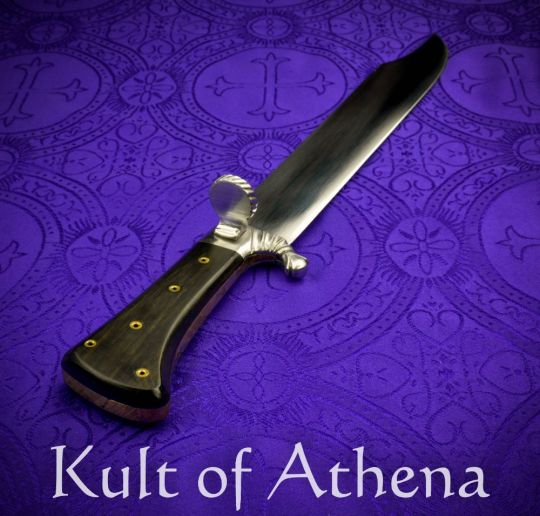

Ádám Bodorics – Brass and Ebony Bauernwehr
This custom crafted Bauernwehr by specialist bladesmith Ádám Bodorics is a fine way to complete your landsknecht kit with a unique and fetching blade suitable for war and camp. The tough and rigid blade of well tempered steel is sharpened and mirror polished – the blade also has a very thick blade spine to ensure it has outstanding durability. The bolster and riveted nagel are steel and the grip is a composite with a hidden and riveted blade tang surmounted by grip scales of ebony and completed with chiseseled brass framing strips. Included is a wooden scabbard which is bound in leather and throrougly embellished with brass. Included is a utility byknife and pricker which neatly fit into integrated slotted compartments on the scabbard. Below are Ádám’s own thoughts on his custom creation:
Bauernwehrs, the dagger-sized relatives of Messers, took a variety of forms utilizing several different construction methods. Details on this set place it firmly into the middle of the 16th century in style.
The blades are forged and ground from 80crv2 high-carbon steel, heat-treated to 54-56 HrC. A shared feature is the heavily tapered tang surrounded by a chiseled brass strap, which detail is taken from an unpublished original studied in a private session. The Gabon ebony grip slabs sit on the frame, with the gap between the slabs and the tang filled with adhesive. This method is taken from surviving frame-hilt sidearms of this and later eras – as it seems universal to frame-hilt pieces from the areas of modern-day Poland, Turkey and Iran, I don’t believe more Western pieces would be constructed differently. All grips
are secured by tubular rivets which are peened, as I have no trust in simple pins.
The principal blade has a short false edge and simple filework on the spine. The bolsters are decorated with filework with the vestigial guard taking the shape of a stylized flower. The Nagel is also fileworked with diagonal lines, matching the scabbard’s finial. It is peened on the other side of the bolsters. The byknife has a simple flat triangular cross-section and brass bolsters with simple geometric decor on it. Normally I find it easier to rivet on the bolsters first and grip slabs after, but thorough study of a surviving frame-hilt knife showed tool marks clearly showing a different order of operations, so this time
it was grip slabs before bolsters.
The pricker is also heat-treated, making it somewhat usable for honing, but my experience and the number of un-heat-treated originals strongly imply that they are much less specialized tools. In a pre-modern setting, without all the comforts we are used to, having a pointy, stiff but non-sharp piece can have a variety of uses from simply punching holes to undoing stubborn knots in arming points. The sheath has goat parchment linings for each blade, which are covered and held together by vegetable tanned leather dyed black by iron-acetate. For bonding the pieces and layers I only used hide glue. The entire piece is reinforced and decorated with a hand-wrought brass sheath frame. While these and similar frames are somewhat rare in reproductions, there are multiple surviving originals ranging from even simpler ones in iron all the way to the sculpted and gilt ones on Holbein daggers. A rather eye- catching detail is the strap around the mouth of the bypiece subsheaths, emulating the puff and slash style of period clothing. While most of the originals I’m aware of in this style are on daggers, there’s plenty of evidence for it’s use on Messers and adjacent sidearms. For suspension, there’s a pair of brass tubes on the back for a leather thong for vertical carry on a belt. The frame is held in place by friction provided by the tight fit around the sheath.
#Kult of Athena#KultOfAthena#New item Wednesday#Ádám Bodorics#Adam Bodorics#Brass and Ebony Bauernwehr#weapon#weapons#blade#blades#Knives & Daggers#Medieval Knives & Daggers#Renaissance Knives & Daggers#Medieval Weapons#Renaissance Weapons#Messer#80crv2 High Carbon Steel#Battle Ready
8 notes
·
View notes